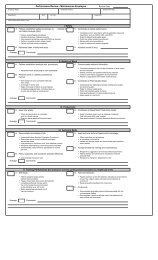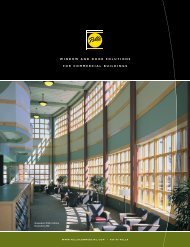Building Operating Management September 2011 - FacilitiesNet
Building Operating Management September 2011 - FacilitiesNet
Building Operating Management September 2011 - FacilitiesNet
Create successful ePaper yourself
Turn your PDF publications into a flip-book with our unique Google optimized e-Paper software.
82 buildingoperatingmanagement<br />
SEPTEMBER <strong>2011</strong><br />
It is important for facility managers to understand the<br />
building and fire code requirements in place in regards<br />
to building security. Although avoiding the installation of<br />
padlocks on exit doors seems to be one of the most fundamental<br />
rules of life safety, locked exit doors still exist. At<br />
the same time, other security measures such as exit control<br />
devices and the locking of doors inside an exit stair<br />
have more complicated life safety implications. When<br />
designing a security system for a building, it is possible<br />
to protect life and property from fire while also ensuring<br />
a secured building. It’s up to facility managers to coordinate<br />
the design of security systems with a fire protection<br />
engineer so that the security and life safety considerations<br />
do not conflict with each other.<br />
q<br />
Make<br />
4.<br />
Sure the Fire<br />
Protection Systems Work<br />
Inspecting, testing and maintaining fire protection<br />
systems is essential to ensuring these life safety systems<br />
respond properly during a building fire. An inspection,<br />
testing and maintenance program needs to be part of any<br />
facility’s fire protection program.<br />
There are numerous types of active and passive fire protection<br />
systems. Active fire protection requires some kind of<br />
“action” or a “response” to a fire for it to provide protection.<br />
Examples of active fire protection systems include: fire sprinkler<br />
systems; special hazard fire protection systems; smoke<br />
management systems; fire alarm and emergency communication<br />
systems; and explosion protection systems. Passive<br />
systems do not need any type of action to protect people and<br />
property from smoke or fire. Passive fire protection systems<br />
include: structural fire protection; fire barriers (e.g., fire-rated<br />
walls, floors and ceilings); opening protection (e.g., fire doors<br />
and windows); and firestopping materials.<br />
Each type of system has its own set of inspection, testing<br />
and maintenance requirements, which makes a comprehensive<br />
program critical. This program should include<br />
type of system, proper procedures, procedure intervals,<br />
who performs the procedure and documentation to show<br />
that the procedure was performed properly.<br />
q<br />
Bring<br />
5.<br />
in an Expert When the<br />
<strong>Building</strong> Changes<br />
Any time a building’s use, occupancy or layout changes<br />
as a result of a building modification (e.g., renovations<br />
and additions), it is essential to ensure that the facility’s<br />
fire protection system is not compromised and the most<br />
efficient fire protection is still being provided. Something<br />
as simple as applying the wrong type of wall finish can<br />
have significant life safety consequences. For example,<br />
It’s what your<br />
boiler would<br />
choose...<br />
Visit www.topog-e.com to learn<br />
more about the world’s most<br />
popular molded rubber handhole<br />
and manway gaskets.<br />
Keep Tabs on the Entire FM Industry …<br />
FROM YOUR POCKET<br />
Easy access to critical industry<br />
info wherever you go, whenever<br />
you need it.<br />
• Timely articles<br />
• Daily Facility Tips<br />
• See the newest products and<br />
services<br />
All on your phone! Available for<br />
iPhone & Blackberry platforms.<br />
Contact us to receive FREE:<br />
● STEAM TEMPERATURE SLIDE RULE<br />
● TECHNICAL SPECIFICATION AND<br />
USAGE GUIDE<br />
● SAMPLE GASKET<br />
● CONTACT DETAILS FOR YOUR LOCAL<br />
DISTRIBUTOR<br />
For further information and a quotation:<br />
1224 North Utica . Tulsa . Oklahoma 74110<br />
(800) 587 7123<br />
tel 918 587 6649 . fax 918 587 6961<br />
sales@topog-e.com . www.topog-e.com<br />
▲ FREE INFO: Circle 456<br />
Sponsored by<br />
Download the <strong>Building</strong> <strong>Operating</strong><br />
<strong>Management</strong> nt Mobile App<br />
Go to www.facilitiesnet.com/<br />
mobile/





